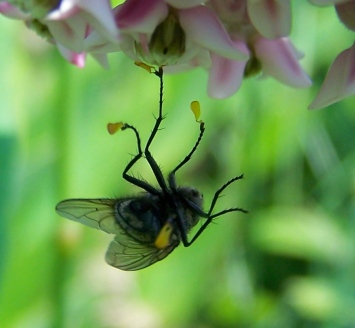
Odontomyia cincta from Kennebunk, ME.
A few days ago I discovered a contender for the most colorful fly in my yard (Idana marginata is a serious competitor for this title): Odontomyia cincta. With lovely orange legs and a body pattern of black and brilliant green stripes, this is one beautiful animal. Most people would probably be surprised to learn that this is a fly at all, given the popular image of flies as dull-colored disease-spreading organisms. I see Odontomyia off and on in my yard, usually either sitting on leaves or nectaring on the dogwood that is flowering in my front garden right now. The genus contains about 31 species in the U.S, and adults are found in woodlands and fields near freshwater habitats, where the young develop. The larvae are “butt breathers” that stick the tip of their abdomen through the water’s surface to obtain air while they graze on algae underwater.

Odontomyia trapped by its tarsi in a milkweed flower. Note the bright orange pollinia (Kennebunk, ME). And yes, I freed it after taking its photo.
Although these are interesting animals in themselves, I was reminded of an even more interesting phenomenon I observed a few years ago that involved Odontomyia. While out “bugging” in a large open field, I stumbled upon quite a few individuals of Odontomyia in a patch of common milkweed. All were trapped by their feet (tarsi) by the milkweed flowers. Nor were they alone – I observed at least three other insect species that had encountered the same problem. Some had managed to escape the flowers’ grasp, while others hung helpless, trying in vain to extricate themselves. What was going on here?

Common Milkweed (Asclepias syriacia)
Common milkweed (Asclepias syriaca) is an amazingly interesting plant native to southern Canada and most of the eastern U.S. It is perhaps most well known as the houseplant for the Monarch butterfly, but it is also host to many other specialist feeders, including two seed bugs, several beetles, and a tiger moth (idea for a future blog post!). When a leaf is broken, a milky substance oozes forth (giving the plant its name), which contains toxic cardiac glycosides that can kill or incapacitate most vertebrates, including humans. These chemicals do not harm the specialist insects that feed on the plant, of course. But it is not only the leaves that pose a threat to other organisms. The large masses of pink flowers contain structures that contain pollen in little packages called pollinia. When an insect brushes against one of these structures, the pollinia clamp onto its leg or proboscis. The idea here is that the insect will break off the pollinia and then visit another milkweed flower, thus completing the process of pollination. However, many insects simply don’t have the muscle to break off the pollinia, and thus end up, like the Odontomyia, stuck helplessly. Only the strongest of insects, such as bumblebees and monarchs, can break loose. Despite the dangers involved, the nectar of milkweed flowers must be very attractive to insects, as individuals that have managed to escape the flowers often return. The fact that the milkweed flowers end up killing quite a few insects does not seem to have any benefit to the plant; it is not carnivorous. Perhaps the decaying insect carcasses, when they finally fall to the ground, provide nutrients to the soil surrounding the milkweed. Something interesting to look into. In any case, yet another reason I’m glad I’m not an insect. Otherwise I’d have to worry about being snared in a bear trap every time I eat something.

One that didn’t make it: an unidentified fly hanging dead from a milkweed flower, with numerous pollinia attached to its tarsi.
Reference:
Frost, S. W. (1965). Insects and pollinia. Ecology, 46(4), 556-558. Retrieved from http://www.jstor.org/stable/1934896?seq=1

So cool, Brandon! Love it!
LikeLike